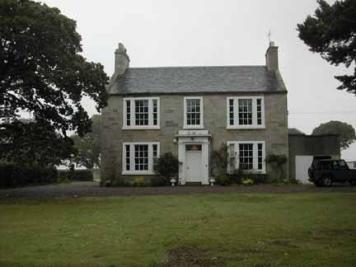 Above is the family mausoleum of Kenneth MacKenzie, his wife Agnes and other members of their family. It is located right next to the plot of the Pearse family that I posted about last Wednesday. There is something very Scottish about the craggy solidity of this structure - and that is fitting for a Scotsman who came out from Scotland to carve out a new life for himself and his family in early Victoria.
Above is the family mausoleum of Kenneth MacKenzie, his wife Agnes and other members of their family. It is located right next to the plot of the Pearse family that I posted about last Wednesday. There is something very Scottish about the craggy solidity of this structure - and that is fitting for a Scotsman who came out from Scotland to carve out a new life for himself and his family in early Victoria.
 | The foundation of his house, now known as Craigflower Manor, had been laid before his arrival in Victoria but the building (on the left) was completed after he came according to his wishes to have it resemble his family home, Renton Hall, in Scotland. Renton Hall is pictured on the right (Photo from virtualmuseum.ca.) Craigflower Manor still stands although since a serious fire some years ago it remains closed to the public. Nevertheless there is an excellent website where one can get a good idea of the furnishings and interior of the house and the kind of life the MacKenzies lived there. Click HERE to visit Craigflower Manor website. |  |
When Mackenzie disembarked in Victoria in 1853 he brought with him his wife Agnes and six children ranging in ages from 8 months to 10 years old. One can only imagine what a 5 months sea voyage must have been like for this young family. However, the Mackenzie children thrived in their new environment. One daughter reminisced, "We were happy as children for it was a great change for us to run wild after a more or less restricted nursery life in Scotland." Mackenzie came to Victoria as an employee of the Hudson Bay Company to develop and manage their farms so as to produce needed foodstuffs and materials for other residents of the new colony and for visiting ships. Another early settler, Dr. John Sebastian Helmcken, described MacKenzie thus: "hale, robust and powerful - a good specimen of a hospitable, warm-hearted 'Scotch laird' a kind of whole souled proper gentleman" (quoted from the
BCheritage website.) Mackenzie later left the company's employ and developed his own sheep farm, Lake Hill Farm, near Christmas Hill, where he and his family lived. One of his grandsons lived there until his death in 1947.
Above is the family mausoleum of Kenneth MacKenzie, his wife Agnes and other members of their family. It is located right next to the plot of the Pearse family that I posted about last Wednesday. There is something very Scottish about the craggy solidity of this structure - and that is fitting for a Scotsman who came out from Scotland to carve out a new life for himself and his family in early Victoria.





4 comments:
Great history and I can only imagine 5 months on a ship was grueling at times. Wow.
Quite a stoic crypt, and a fascinating history!
I've featured this same structure in my blog a few times.
Other interesting structures are the Blue Angel, the large raven(?) that adorns one stone on the south side, and the nun at the other end of the cemetery. She reminds me of the Mona Lisa as she has this half-knowing smile as she gazes down at you.
I find the best time for Ross Bay Cemetery shots is the fall. There's something about the fallen leaves and the grey skies that adds gravity to the images you get, as cliché as that sounds.
Post a Comment